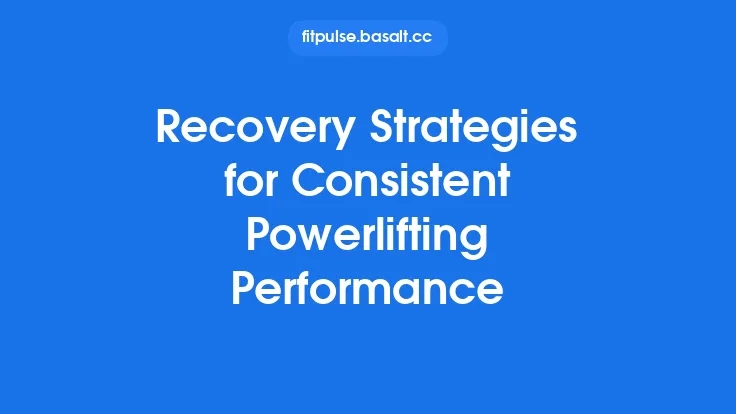Recovering from a workout isn’t just about refueling muscles with protein and carbs; the water you drink plays a pivotal role in how quickly and effectively your body bounces back. Proper hydration supports everything from nutrient transport to waste removal, and it helps maintain the delicate balance of fluids that keeps cells functioning optimally. Below, we’ll explore the most reliable, science‑backed strategies to hydrate for recovery after any type of training session—whether you’re lifting, sprinting, or doing a yoga flow.
1. Why Hydration Is Central to Recovery
Water makes up roughly 60 % of an adult’s body weight and is the medium in which virtually every biochemical reaction occurs. After exercise, the body experiences several fluid‑related challenges:
- Plasma Volume Depletion – Sweat loss reduces the volume of blood plasma, limiting the delivery of oxygen and nutrients to damaged muscle fibers.
- Metabolic Waste Accumulation – Byproducts such as lactate, urea, and free radicals need to be cleared; water facilitates their transport to the kidneys and liver for elimination.
- Cellular Repair Processes – Protein synthesis, glycogen resynthesis, and membrane repair all rely on adequate intracellular water to maintain proper enzyme activity and structural integrity.
- Thermoregulation – Even after you stop moving, the body continues to dissipate heat. Sufficient fluid stores help keep core temperature stable during the recovery period.
When hydration is suboptimal, you may notice prolonged muscle soreness, reduced strength in subsequent sessions, and a slower return to baseline performance.
2. The Physiology of Rehydration: From Skin to Cells
Understanding how water moves through the body can guide smarter rehydration tactics.
| Step | What Happens | Why It Matters |
|---|---|---|
| Ingestion | Water enters the stomach and small intestine, where it is absorbed into the bloodstream. | Rapid absorption (especially with plain water) helps restore plasma volume quickly. |
| Distribution | Blood circulates water to capillaries, delivering it to interstitial spaces and cells. | Efficient distribution ensures that muscles receive the fluid they need for repair. |
| Cellular Uptake | Osmotic gradients drive water into muscle cells, expanding cell volume (cellular swelling). | Slight swelling can act as an anabolic signal, promoting protein synthesis and reducing catabolism. |
| Excretion | Kidneys filter excess water, maintaining electrolyte balance. | Over‑hydration can dilute blood sodium, so moderation is key. |
The speed of each step depends on factors such as temperature of the fluid, presence of small amounts of solutes (e.g., a pinch of salt), and the individual’s hydration status before the workout.
3. Timing Your Post‑Workout Fluid Intake
3.1 Immediate Rehydration (0–30 minutes)
- Goal: Replace the bulk of fluid lost through sweat and kick‑start plasma volume restoration.
- Strategy: Consume 16–24 oz (≈ 0.5–0.7 L) of plain water within the first 15 minutes after finishing. This amount aligns with the average sweat loss for most moderate‑intensity sessions (≈ 0.5–1 L per hour).
3.2 Continued Rehydration (30 minutes–2 hours)
- Goal: Fine‑tune fluid balance and support ongoing metabolic processes.
- Strategy: Sip an additional 8–12 oz (≈ 250–350 mL) every 20 minutes for the next hour. This gradual approach prevents sudden shifts in blood volume that can cause gastrointestinal discomfort.
3.3 Long‑Term Hydration (2–24 hours)
- Goal: Ensure total fluid replacement and maintain optimal cellular environment for repair.
- Strategy: Track overall fluid intake throughout the day, aiming for a net gain of 1–2 L above baseline (the amount you would normally drink on a non‑training day). This can be achieved through regular water consumption, water‑rich foods, and mindful sipping.
4. Practical Ways to Optimize Fluid Volume
| Technique | How to Implement | Benefits |
|---|---|---|
| Pre‑Workout Hydration Buffer | Drink 8–12 oz of water 2–3 hours before training, then another 4–6 oz 20 minutes prior. | Starts the session with a full fluid reservoir, reducing the relative loss during exercise. |
| Post‑Workout “Hydration Window” | Set a timer for 30 minutes after training; use it as a cue to finish your first 16–24 oz of water. | Creates a habit that ensures you never miss the critical early rehydration phase. |
| Use a Measured Bottle | Keep a 32‑oz bottle labeled with “0 min,” “15 min,” “30 min,” etc., and mark the amount to drink at each interval. | Visual feedback helps you stay on track without guessing. |
| Temperature Matters | Opt for cool (not ice‑cold) water (≈ 50–60 °F / 10–15 °C). | Cool water is absorbed faster than very cold water, which can cause stomach tightness. |
| Flavor Without Sugar | Add a slice of citrus, cucumber, or a few berries to your water. | Improves palatability, encouraging higher intake without adding unnecessary calories or sugars. |
| Hydration‑Focused Snacks | Include foods with high water content (e.g., watermelon, cucumber, oranges) as part of your post‑workout snack. | Provides additional fluid while delivering micronutrients. |
| Avoid Over‑Dilution | If you’re drinking large volumes quickly, consider a pinch of sea salt (≈ ¼ g) to maintain plasma osmolality. | Prevents hyponatremia risk without turning the drink into a full electrolyte solution. |
5. Monitoring Hydration Status Without Fancy Tools
You don’t need a lab to know whether you’re adequately rehydrated. Simple, reliable cues include:
- Urine Color: Aim for a pale straw hue. Darker amber suggests a need for more fluids.
- Body Weight Change: Weigh yourself before and after a workout. A loss of 1 % body weight (≈ 1 lb per 100 lb) typically reflects a fluid deficit that should be replaced.
- Thirst Perception: While not perfect, feeling thirsty after a session is a clear sign you need to drink.
- Physical Sensations: Lightheadedness, dry mouth, or a rapid heartbeat during recovery can indicate insufficient fluid replacement.
By regularly checking these indicators, you can adjust your intake on the fly and avoid chronic under‑ or over‑hydration.
6. Special Considerations for Different Training Modalities
| Modality | Typical Sweat Loss | Hydration Recommendation |
|---|---|---|
| High‑Intensity Interval Training (HIIT) | 0.5–1 L per hour (often with high temperature) | Prioritize rapid post‑workout water intake; consider a brief cool‑down to lower core temperature before drinking. |
| Resistance Training (Weightlifting) | 0.3–0.7 L per hour (lower than cardio) | Focus on steady sipping during rest periods and a solid water dose after the session. |
| Yoga / Pilates | 0.2–0.5 L per hour (often in warm rooms) | Warm water can be soothing; maintain hydration throughout the class to avoid stiffness. |
| Outdoor Endurance (Running, Cycling) | 1–2 L per hour (environment dependent) | While this borders on endurance‑specific advice, the principle remains: replace fluid loss proportionally, using the timing guidelines above. |
Even within a single workout, sweat rates can vary dramatically based on ambient temperature, humidity, and individual physiology. Adjust your fluid plan accordingly.
7. Common Myths About Post‑Workout Hydration
| Myth | Reality |
|---|---|
| “You must drink a gallon of water after every workout.” | Over‑drinking can dilute blood sodium and cause discomfort. Replace roughly the amount you lost (≈ 0.5–1 L per hour of exercise) plus a modest extra amount for ongoing recovery. |
| “Cold water is always better because it feels refreshing.” | Very cold water can slow gastric emptying, leading to a feeling of fullness. Cool water is absorbed more efficiently. |
| “If I’m not thirsty, I don’t need to drink.” | Thirst lags behind actual fluid deficits, especially after intense exercise. Use objective measures (weight change, urine color) to guide intake. |
| “All sports drinks are necessary for recovery.” | For most moderate workouts, plain water provides sufficient rehydration. Sports drinks become more relevant only when sweat losses exceed 2 L and electrolyte replacement is needed. |
8. Building a Personal Hydration Routine
- Assess Baseline Needs – Track your typical water intake on rest days for a week. This gives you a reference point.
- Log Workout Sweat Loss – Weigh yourself pre‑ and post‑session (without clothes) to estimate fluid loss.
- Create a Simple Schedule – Use the 0‑30‑60‑120 minute framework to structure water consumption.
- Adjust for Environment – On hot, humid days, add an extra 8–12 oz to each interval.
- Review Weekly – Check urine color and body weight trends. If you notice consistent dark urine or weight loss after workouts, increase your fluid volume.
By turning hydration into a repeatable habit rather than an after‑thought, you’ll support faster muscle repair, reduce soreness, and be ready for the next training session.
9. The Bottom Line
Optimal recovery hinges on more than just macronutrients; water is the silent workhorse that transports those nutrients, clears metabolic waste, and creates the cellular environment needed for repair. By:
- Prioritizing immediate fluid replacement,
- Spacing intake over the first two hours post‑exercise,
- Choosing cool, palatable water (with optional natural flavorings),
- Monitoring simple hydration cues, and
- Tailoring the plan to your specific training and environment,
you’ll give your body the best chance to bounce back stronger after every workout. Consistency is key—make hydration an integral part of your recovery routine, and the benefits will show up in reduced soreness, improved performance, and a healthier, more resilient body.





